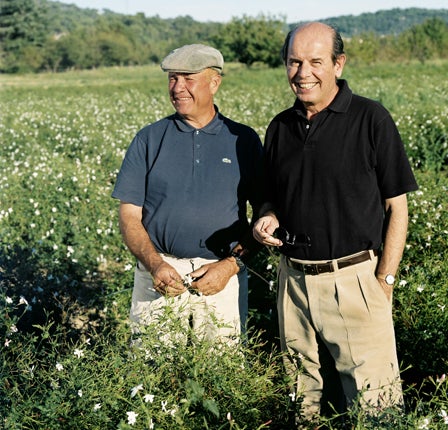The sweet smell of success
Chanel will only allow the very best jasmine to make its signature No 5 perfume, and that has come from the same fields in Provence for the last 88 years. Geneviève Roberts finds out how the farmers stay on the scent

It is hard to imagine what might connect a crinkle-faced farmer in Provence to either Marilyn Monroe or Audrey Tautou. The clue is in the explosion of white flowers around him. Every August Joseph Mul and his workers fan out across the fields in this far south-eastern corner of France to hand-pick the delicate petals of jasmine that go into the world's most famous perfume: Chanel No. 5.
The 70-year-old is the fifth generation of his family to work for the perfume house. The farm has been involved with the signature No. 5 scent – a bottle of which is sold every 55 seconds – since its inception in 1921. Indeed the olfactory combination is so unique that the Chanel formula actually specifies the precise origin of the white flowers used.
"It's the most expensive jasmine in the world," the farmer explains. "It's a sweeter scent, less aggressive and softer than exotic jasmine. It would be a different perfume if the flowers were cultivated elsewhere."
The glamourous starlets who daub their neck and wrists with the perfume, and the hordes who pile through the revolving doors of Parisian department stores such as Galeries Lafayette and Printemps, are a world removed from the family-run jasmine harvest based on the town of Grasse.
"The process cannot be mechanised," Mr Mul insists. So it is a painstaking endeavour. The plant flourishes at night, and each morning, the harvesters rise to start picking the crop at 6am, piling the petals in wicker baskets.
"One person picks half a kilo of flowers an hour by hand," the farmer says.
Mr Mul, who works with his brother Marius, employs at least 70 people every year to help pick the five hectares of flowers, all by hand, during the three-month harvest that starts in August. Many of them are members of his family. "Our children work with us, each generation is involved, and we have a regular group of people who help with the harvest each year," he said.
Chanel safeguarded the crop two decades ago, at a time when exotic jasmine was flourishing in more far-flung climes. "We're between 20 and 30 times more expensive than the jasmine produced in Egypt or India," Mr Mul said.
"We live in a privileged micro- climate on the Côte d'Azur, where it's not too hot in summer, which means our jasmine is of an exceptional quality. The optimum is for the temperature at night to remain above 18 degrees, and to never rise above 28 degrees in the sun."
He is clearly passionate about his work. He recounts the story of how the world-famous scent, worn in bed by Monroe and now being advertised by the French actress Tautou, got its name. Coco Chanel commissioned perfumer Ernest Beaux to create six scents for her to choose from in 1921, and she liked number five, also her lucky number, which was rich in may rose and jasmine for its middle notes.
Once the jasmine flowers in Grasse have been picked, they have to be quickly treated. "We immediately put them in contact with the extraction solvent hexane. If they're left for any time, the scent starts to decay," explains Jean-François Vieille, who has spent the last two decades turning the crop into a caramel-coloured solid, known as concrete, that can be easily transported.
"During the harvest, we work for as many hours as it takes. But we don't count hours; the flowers need harvesting every day. I do the best I can to produce a high-quality ingredient: we must take care because we work for a high-quality perfumery," he said. One kilogram of petals means picking around 8,000 raw flowers, and 350 kilos are needed to make one kilo of concrete, worth between €9,000 and €10,000 (£8,600). "When the lorries transport the concrete to Paris for Chanel, we do not tell them what is inside," Mr Vieille said. "Fortunately, we have never lost a lorry."
This year, some perfume enthusiasts had feared that new regulations from the International Fragrance Association (IFRA), which come into effect next January, would spell the end of Chanel No. 5. The use of natural jasmine will, for the first time, be restricted in all perfumes to 0.7 per cent of the finished product, to ensure that wearers have no allergic reaction to the flower.
The Paris-based fragrance historian Octavian Sever Coifan wrote on her blog that this would "represent the end of Chanel No. 5 legend."
But Jean-Pierre Houri, head of the IFRA, was categorical in his denial.
"Chanel No. 5 will be unaffected by the IFRA restrictions." And a spokesperson for Chanel said that "Evidently when the new standards were issued we immediately checked the percentages in our finished products and in none of our fragrances is the recommended level exceeded."
Back in Grasse, the scent capital of the world where the air is infused with the town's €600m a year perfume industry, workers are equally unfazed. The only thing worrying Mr Mul is the fungus attacking the roots of the flower. But he is quick to add that they take the precaution of growing 20 per cent more flowers than needed, just in case the crop is attacked.
"We have never lost a harvest," he said, reassuringly. "And the conditions this year were optimal."
Join our commenting forum
Join thought-provoking conversations, follow other Independent readers and see their replies
Comments